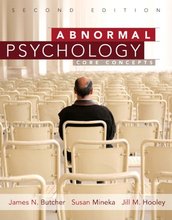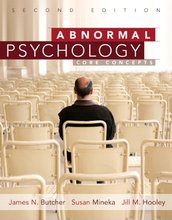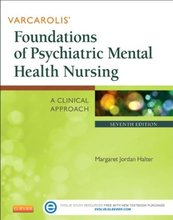Instant download Abnormal Psychology Core Concepts Butcher 2nd Edition Test Bank pdf docx epub after payment.

Product details:
- ISBN-10 : 020576844X
- ISBN-13 : 978-0205768448
- AUthor: James N. Butcher; Susan M Mineka
A briefer version of the most authoritative and respected introductory text for the abnormal psychology course. This allows instructors who prefer less detail to still use a research-oriented text. As in their more comprehensive version, the esteemed author team of Jim Butcher, Sue Mineka and Jill Hooley offers students a thoroughly researched and up-to-date explanation of psychopathology, creating a learning experience that invokes thought, increases awareness, and takes students to levels of understanding that other books do not offer.
Table of contents:
1. Abnormal Psychology Over Time
2. Causal Factors and Viewpoints
3. Clinical Assessment, Diagnosis, and Treatment Approaches
4. Stress and Stress-Related Disorders
5. Panic, Anxiety, and Their Disorders
6. Mood Disorders and Suicide
7. Somatoform and Dissociative Disorders
8. Eating Disorders and Obesity
9. Personality Disorders
10. Substance-Related Disorders
11. Sexual Variants, Abuse, and Dysfunctions
12. Schizophrenia and Other Psychotic Disorders
13. Cognitive Disorders
14. Disorders of Childhood and Adolescence
15. Contemporary and Legal Issues in Abnormal Psychology
DETAILED TABLE OF CONTENTS:
Features, xvi
Preface, xix
Chapter 1. Abnormal Psychology over Time, 1
What Do We Mean by Abnormality?, 3
The DSM-IV Definition of Mental Disorder, 5
Why Do We Need to Classify Mental Disorders?, 6
What Are the Disadvantages of Classification?, 6
How Does Culture Affect What Is Considered Abnormal?, 7
Culture-Specific Disorders, 8
How Common Are Mental Disorders?, 8
Prevalence and Incidence, 9
Prevalence Estimates for Mental Disorders, 9
Historical Views of Abnormal Behavior, 10
Demonology, Gods, and Magic, 11
Hippocrates’ Early Medical Concepts, 11
Later Greek and Roman Thought, 12
Views of Abnormality During the Middle Ages, 12
The Resurgence of Scientific Questioning in Europe, 13
The Establishment of Early Asylums, 13
Humanitarian Reform, 13
Mental Hospital Care in the Twenty-First Century, 15
The Emergence of Contemporary Views of Abnormal Behavior, 16
Biological Discoveries: Establishing the Link Between the Brain and Mental Disorder, 17
The Development of a Classification System, 17
The Development of the Psychological Basis of Mental Disorder, 18
The Evolution of the Psychological Research Tradition: Experimental Psychology, 20
Research Approaches in Abnormal Psychology, 22
Sources of Information, 22
Forming and Testing Hypotheses, 23
Research Designs, 25
Manipulating Variables: The Experimental Method in Abnormal Psychology, 26
Developments in Research 1.1: Do Magnets Help with Repetitive-Stress Injury?, 28
Unresolved Issues: Are We All Becoming Mentally Ill? The Expanding Horizons of Mental Disorder, 31
Summary, 31
Key Terms, 33
Chapter 2. Causal Factors and Viewpoints, 34
Causes and Risk Factors for Abnormal Behavior, 35
Necessary, Sufficient, and Contributory Causes, 35
Diathesis-Stress Models, 36
Viewpoints for Understanding the Causes of Abnormal Behavior, 38
The Biological Viewpoint and Causal Factors, 38
Neurotransmitter and Hormonal Abnormalities, 39
Developments in Research 2.1: Neurotransmission and Abnormal Behavior, 40
Genetic Vulnerabilities, 42
Developments in Thinking 2.2: Nature, Nurture, and Psychopathology: A New Look at an Old Topic, 44
Temperament, 45
Brain Dysfunction and Neural Plasticity, 46
The Impact of the Biological Viewpoint, 47
The Psychological Viewpoints, 47
The Psychodynamic Perspectives, 48
The Behavioral Perspective, 52
Developments in Thinking 2.3: The Humanistic and Existential Perspectives, 53
The Cognitive-Behavioral Perspective, 56
Psychological Causal Factors, 58
Early Deprivation or Trauma, 59
Inadequate Parenting Styles, 61
Marital Discord and Divorce, 63
Maladaptive Peer Relationships, 64
The Sociocultural Viewpoint and Causal Factors, 65
Uncovering Sociocultural Factors Through Cross-Cultural Studies, 66
Harmful Societal Influences, 67
The Impact of the Sociocultural Viewpoint, 69
Unresolved Issues: Theoretical Viewpoints and the Causes of Abnormal Behavior, 70
Summary, 71
Key Terms, 72
Chapter 3. Clinical Assessment, Diagnosis, and Treatment Approaches, 74
The Basic Elements in Assessment, 75
The Relationship Between Assessment and Diagnosis, 75
Taking a Social or Behavioral History, 75
Ensuring Culturally Sensitive Assessment Procedures, 76
Assessment of the Physical Organism, 77
The General Physical Examination, 77
The Neurological Examination, 77
The Neuropsychological Examination, 79
Psychosocial Assessment, 79
Assessment Interviews, 79
The Clinical Observation of Behavior, 80
Psychological Tests, 81
Advantages and Limitations of Objective Personality Tests, 86
The Integration of Assessment Data, 86
Classifying Abnormal Behavior, 87
Reliability and Validity, 88
Formal Diagnostic Classification of Mental Disorders, 88
An Overview of Treatment, 90
Psychosocial Approaches To Therapy, 91
Behavior Therapy, 91
Cognitive and Cognitive-Behavioral Therapy, 92
Humanistic-Experiential Therapies, 94
Psychodynamic Therapies, 96
Couple and Family Therapy, 98
Eclecticism and Integration, 100
Measuring Success in Psychotherapy, 100
Objectifying and Quantifying Change, 101
Would Change Occur Anyway?, 101
Can Therapy Be Harmful?, 101
Biological Approaches to Treatment, 102
Antipsychotic Drugs, 102
Antidepressant Drugs, 103
Anti-Anxiety Drugs, 107
Lithium and Other Mood-Stabilizing Drugs, 107
Electroconvulsive Therapy, 109
Neurosurgery, 110
Developments in Research 3.1: Treating Depressed Patients with Deep Brain Stimulation, 111
Unresolved Issues: Is There Bias in the Reporting of Drug Trials?, 111
Summary, 112
Key Terms, 114
Chapter 4. Stress and Physical and Mental Health, 115
What Is Stress?, 116
Stress and the DSM, 116
Factors Predisposing a Person to Stress, 117
Characteristics of Stressors, 118
Stress and the Stress Response, 119
Biological Costs of Stress, 120
The Mind-Body Connection, 120
Understanding the Immune System, 120
Developments in Research 4.1: Cytokines: The Link Between the Brain and the Immune System, 122
Stress and Physical Health, 122
Attitudes and Health, 122
Optimism, 122
Negative Affect, 123
Cardiovascular Disease, 123
Hypertension, 123
Coronary Heart Disease, 125
Risk and Casual Factors in Cardiovascular Disease, 125
Treatment of Stress-Related Disorders, 127
Emotional Disclosure, 127
Biofeedback, 128
Relaxation and Meditation, 128
Psychological Reactions to Stress, 128
Adjustment Disorder, 129
Post-Traumatic Stress Disorder, 129
Clinical Description, 129
Prevalence of PTSD in the General Population, 130
Rates of PTSD After Exposure to Specific Stressors, 131
Causal Factors in Post-Traumatic Stress Disorder, 132
Long-Term Effects of Post-Traumatic Stress, 134
Prevention and Treatment of Stress Disorders, 135
Prevention, 135
Treatment for Stress Disorders, 135
Trauma and Physical Health, 138
Unresolved Issues: What Should the Diagnostic Criteria for PTSD Be?, 138
Summary, 139
Key Terms, 140
Chapter 5. Panic, Anxiety, and Their Disorders, 141
The Fear and Anxiety Response Patterns, 143
Overview of the Anxiety Disorders and Their Commonalities, 144
Specific Phobias, 145
Prevalence, Age of Onset, and Gender Differences, 146
Psychological Causal Factors, 146
Biological Causal Factors, 148
Treatments, 149
Social Phobias, 150
Prevalence, Age of Onset, and Gender Differences, 151
Psychological Causal Factors, 151
Biological Causal Factors, 152
Treatments, 153
Panic Disorder with and without Agoraphobia, 154
Panic Disorder, 154
Agoraphobia, 155
Prevalence, Age of Onset, and Gender Differences, 156
The Timing of a First Panic Attack, 156
Biological Causal Factors, 157
Psychological Causal Factors, 158
Treatments, 161
Developments in Practice 5.1: Cognitive-Behavioral Therapy for Panic Disorder, 162
Generalized Anxiety Disorder, 163
Prevalence, Age of Onset, and Gender Differences, 164
Psychological Causal Factors, 165
Biological Causal Factors, 166
Treatments, 167
Obsessive-Compulsive Disorder, 168
Prevalence, Age of Onset, and Gender Differences, 170
Psychosocial Causal Factors, 170
Biological Causal Factors, 172
Treatments, 174
Sociocultural Causal Factors for all Anxiety Disorders, 175
Cultural Differences in Sources of Worry, 176
Taijin Kyofusho, 176
Unresolved Issues: Compulsive Hoarding: Is it a Subtype of OCD?, 177
Summary, 177
Key Terms, 179
Chapter 6. Mood Disorders and Suicide, 180
Mood Disorders, 181
What are Mood Disorders?, 181
Types of Mood Disorders, 182
The Prevalence of Mood Disorders, 183
Unipolar Mood Disorders, 183
Depressions That Are Not Mood Disorders, 184
Dysthymic Disorder, 185
Major Depressive Disorder, 186
Causal Factors in Unipolar Mood Disorders, 189
Biological Causal Factors, 189
Psychological Causal Factors, 193
Developments in Research 6.1: Sex Differences in Unipolar Depression, 199
Developments in Thinking 6.2: Comorbidity of Anxiety and Mood Disorders, 201
Bipolar Disorders, 203
Cyclothymic Disorder, 203
Bipolar Disorders (I and II), 204
Causal Factors In Bipolar Disorder, 207
Biological Causal Factors, 207
Psychosocial Causal Factors, 208
Sociocultural Factors Affecting Unipolar and Bipolar Disorders, 209
Cross-Cultural Differences in Depressive Symptoms, 209
Cross-Cultural Differences in Prevalence, 210
Demographic Differences in the United States, 210
Treatments and Outcomes, 211
Pharmacotherapy, 211
Alternative Biological Treatments, 213
Psychotherapy, 213
Suicide, 215
The Clinical Picture and the Causal Pattern, 216
Who Attempts and Who Commits Suicide?, 216
Suicide in Children, 216
Suicide in Adolescents and Young Adults, 217
Other Psychosocial Factors Associated with Suicide, 217
The World Around Us 6.3: Warning Signs for Student Suicide, 218
Biological Causal Factors, 218
Sociocultural Factors, 218
Communication of Suicidal Intent, 219
People also search:
Abnormal Psychology Core Concepts
Abnormal Psychology Core Concepts Butcher Mineka Hooley
Abnormal Psychology Core Concepts Butcher Mineka Hooley 2nd
Abnormal Psychology Core Concepts Butcher Mineka Hooley 2nd Test Bank
Abnormal Psychology Core Concepts Butcher 2nd Edition Test Bank





